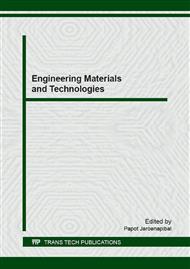p.143
p.148
p.157
p.163
p.169
p.177
p.184
p.191
p.196
Physical and Thermal Properties of Fired Clay Bricks Mixed with Rice Husk Ash and Fly Ash
Abstract:
Thailand is located in a tropical region, with high intensity of sunlight, high temperature and humidity. Thus, preventing heat transfer into the building is required in order to save electrical energy for air-conditioning systems. This study aims to investigate the physical and thermal properties of construction bricks in order to increase their effectiveness of heat prevention. An attempt is made to increase discontinuous voids in fired clay bricks. Rice Husk Ash (RHA; 0-30 % by weight) and Fly Ash (FA; 0-30 % by weight) were added in brick mixture to increase those voids. Compressive strength and water absorption of bricks were tested. The testing results showed that compressive strength decreased and water absorption increased when RHA and FA were added. The thermal conductivity coefficient of bricks were also investigated. The results confirmed that the higher amount of RHA added, the higher thermal resistance of bricks. Similar results were found for FA. Increasing an amount of FA also increased thermal resistance of bricks. Thermal time-lag behavior was also tested. The results showed that RHA hollow bricks took the longest time in heating and took the shortest time in cooling. These properties are good for heat prevention. These bricks which were developed and tested in this research are conformed to the Thai Industrial Standard. Finally, it can be concluded that because of its thermal behavior, RHA hollow brick is a suitable energy-saving brick for hot and humid climates.
Info:
Periodical:
Pages:
169-176
Citation:
Online since:
November 2016
Authors:
Keywords:
Price:
Сopyright:
© 2017 Trans Tech Publications Ltd. All Rights Reserved
Share:
Citation:


